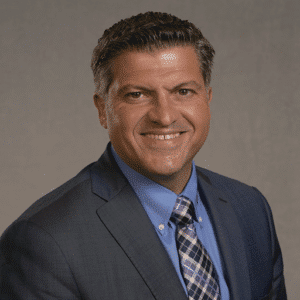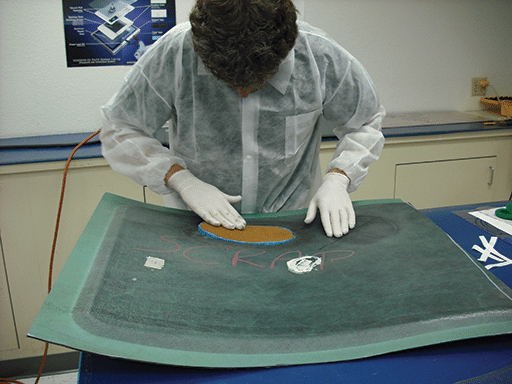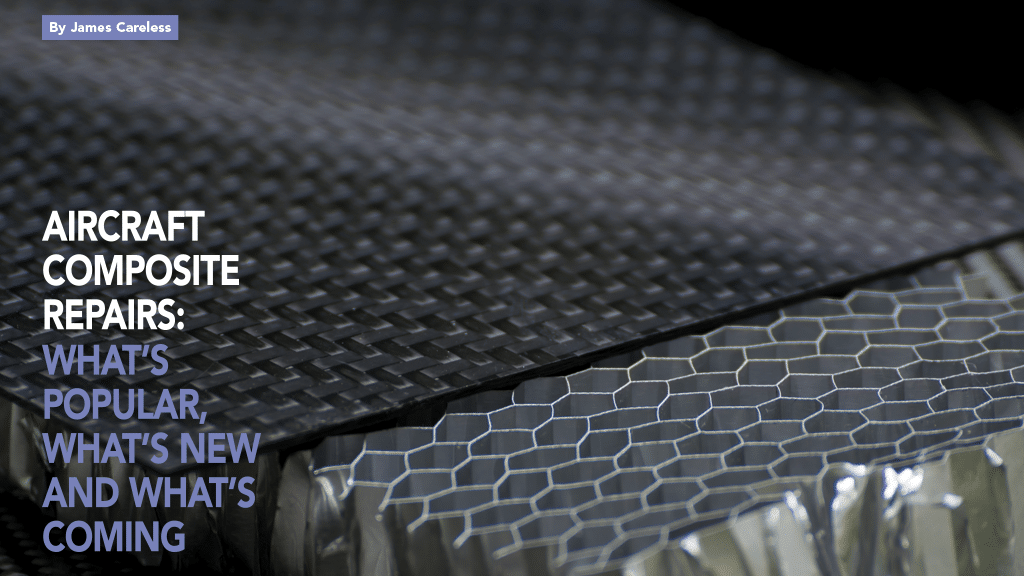The days of aircraft composite repairs being unique and exotic are over. The popularity of carbon fiber and other composite materials in aircraft means that repairs to these structures are becoming standard procedures at MROs worldwide.
So, what kinds of composite repairs are common, what advances have been made to these repair techniques, and what future advances are coming? To find the answers to these and other questions that matter to MROs, Aviation Maintenance magazine spoke with three composite repair experts. They are Eitan Danan, head of the composites department at the IAI Bedek Aviation Group; Lorenzo Marandola, president of M1 Composites Technology; and Louis C. Dorworth, direct services division manager at Abaris Training Resources, which teaches technicians how to work with aircraft composite materials and perform repairs.
Common Composite Repairs
To put aircraft composite repairs into context, we began by asking about the most common aircraft composite repairs and the challenges associated with them.
At the IAI Bedek Aviation Group (IAI), “our focus is on repairing structural elements such as fuselage skins and wing structures that have been affected by wear and environmental factors,” said Eitan Danan. “The B-767-300 is the most commonly serviced aircraft in our hangars. IAI performs heavy maintenance for many airlines, which involves removing all interior components, including seats, galleys, lavatories and overhead bins, inspecting them and sending them to the composite or sheet metal shops.”
Finding damaged aircraft composites during maintenance inspections is a regular occurrence. To address them, IAI’s composite shop performs repairs in accordance with the structural repair manual, using hot bonder consoles, heat blankets, and vacuum bags. “In some cases, significant damage can occur during in-flight maintenance,” Danan said. “These repairs require engineering support and Boeing responds with structural composite repairs using advanced equipment and in-house expertise.”
Worth noting: Aircraft lavatories are often the most problematic areas encountered during composite repairs, due to severe corrosion on the lower metal fittings. To address this issue, IAI’s composite and sheet metal shops collaborate to manufacture new fittings and fasteners that adhere to the manufacturer’s technical specifications.

Maranrdola
M1 Composites Technology’s expertise lies in composite structure repairs, with a focus on remedying common issues encountered in components like radomes and leading edges. “These repairs are often necessitated by factors such as bird strikes, hail, and environmental wear,” said Lorenzo Marandola.
As well, water penetration into aircraft composite materials and subsequent delamination are frequent problems that M1 addresses, particularly in nacelles and cowls subjected to significant vibration and stress. “To tackle these challenges, we employ advanced non-destructive testing (NDT) methods to identify areas of concern and undertake precise restoration work, often involving the careful removal and rebuilding of damaged sections to ensure optimal structural integrity and performance,” Marandola said.

Dorworth
To prepare MRO technicians to fix these and other aircraft composite repairs, Abaris Training Resources primarily teaches taper-scarf repair methods in their courses. “This is because these methods are preferred by original equipment manufacturers (OEMs) for a majority of composite structures and are called for in their structural repair manuals (SRMs),” said Dorworth.
When it comes to doing these repairs successfully, education is a must. “This is because problems mostly occur due to personnel that may have on-the-job training skills but greatly lack the fundamental knowledge required to be proficient with composite materials and processing,” Dorworth said. “Unlike metals that already have given mechanical properties, composite materials require that the properties of the patch are developed by choosing the right resin, orienting the fibers, and curing the resin/adhesive properly. This is where formal training fills the void, providing competent and confident mechanics and technicians that understand the underlying material and process knowledge necessary to provide airworthy repairs.”
Recent Advances
According to the experts, the science of aircraft composite repair has progressed considerably as composites have achieved widespread acceptance in the aviation industry.
“Recent years have seen notable advancements in repair equipment, particularly in terms of precision and control during the curing process of composite materials,” said Marandola. “With the shift towards larger aircraft structures constructed from composites, such as the A320 NEO and B737MAX, there has been an increased demand for autoclaves to effectively cure these components. These developments have enabled more precise and efficient repairs, ensuring the integrity and longevity of composite aircraft structures.”
According to Dorworth, the quality of adhesives, resins, and ‘prepregs’ (pre-impregnated materials) used in composite repairs is where the biggest advances have occurred over the last 20 years. These improvements support the use of lower temperature hot bonding processes, resulting in higher performance properties in the final repair. “Today’s focus is on achieving the best performance from cobonded repair patches for primary structures, versus what was acceptable for the secondary structures of yesteryear,” he said.
Ongoing Challenges
Even with advances in aircraft composite repairs, challenges remain.
A case in point: Detecting damage to composites that is not visible externally remains a significant challenge. “Consequently, ongoing research efforts are focused on developing improved methods for detecting heavy internal damage, which may be concealed from plain view,” said Marandola. “However, it’s worth noting that the OEMs responsible for designing and manufacturing these aircraft are best positioned to assess whether their assumptions regarding damage occurrence have been accurate. As they continue to gather data and refine their understanding of composite material behavior in real-world scenarios, insights gained from OEMs will be crucial for shaping future repair strategies and advancements.”
Being able to repair damage after it has been detected can also be a challenge. The reason? “As with everything, the original lab level studies that go into the repair design instructions do not always translate to the challenges found in the real world for many reasons,” Dorworth said. “Because of this, there have been a number of ‘issues’ that have popped up as new aircraft with carbon fiber reinforced polymeric (CFRP) structures have found their way into service. For the most part these challenges have been dealt with accordingly and are now mainstream.”
Then there’s the challenge of dealing with composite repair issues that are much larger than usually encountered. For example, there was the case of the Ethiopian Airlines 787 that experienced a battery fire in 2013. Fixing this Dreamliner required “a new piece of the composite fuselage to be fabricated, sectioned, and replaced at the upper aft section near the vertical stabilizer,” said Dorworth.
Of course, just the fact that composite materials are still comparatively new to aviation (compared to metal) explains why unexpected repair issues are still occurring. “As always, every time a new component or technology comes into the picture, it brings with it new problems and challenges,” Danan observed.

Tackling the Challenges
Fortunately for composite aircraft operators and owners, the companies interviewed for this article are taking action to address the repair challenges noted above, and many others. AT IAI, for instance, “we have developed comprehensive repair procedures, combining standard and innovative methods, focusing on international standards compliance and staff training,” said Danan.
The same is true for M1 Composites Technology. “Our company has undertaken several initiatives to develop repair procedures for composites,” Marandola said. “We utilize reverse engineering techniques to understand the original manufacturing processes and materials used in composite components. Additionally, we have assembled a specialized team of composite technicians and a dedicated engineering team with expertise in composites. Our extensive experience working on legacy platforms informs our approach to repairs on newer aircraft, allowing us to adapt and innovate effectively.”
This being said, finding ways to address composite repair challenges comes with challenges of its own. For example, “composite material properties are often proprietary to OEMs, making it challenging to ascertain original strength and manufacturing methods. As a result, substantiating repairs can be more complex,” said Marandola. “Moreover, the specialized tooling required for composite repairs, such as autoclaves, can be costly. Additionally, higher inspection and non-destructive testing (NDT) requirements further contribute to the challenges associated with composite repairs.”
To help MRO technicians successfully remedy composite issues through education, Abaris Training Resources has been working closely with organizations such as SAE/PRI and aircraft OEMs to develop relevant repair methods and standards for commercial/general aviation repairs. “We currently have a representative on the PRI Composite Repair Review Board, developing training and testing standards for aerospace composite repair technician certification,” Dorworth said. “In the past we have worked directly with OEMs in developing repair methods for higher altitudes over 8,000 feet. We have also worked with organizations and customers to develop and deploy repair methods within their own facilities by offering Repair Design, Analysis, and Substantiation courses to engineers.”
All this being said, our experts believe that composite aircraft OEMs could be doing more to improve the aircraft composite repair process.
One way OEMs could help is by standardizing repair procedures and materials across different aircraft platforms, which could significantly improve the efficiency and effectiveness of composite repairs. “Currently, variations in materials and procedures present challenges, as each material may have different characteristics and shelf life,” said Marandola. “By OEMs adopting common materials and procedures, MROs would be able to streamline their operations and reduce costs. Additionally, investing in the development of alternative materials that require less complex curing processes, such as heat blankets or room temperature cures, would simplify the repair process and increase flexibility.”
Another way is suggested by IAI’s Danan. “To simplify composite repairs, we propose creating a unified database of repair types based on SRM (structural repair manuals),” he said. “Based on our experience, we believe that this approach can expedite and streamline such repairs.”
If adopted, these suggestions would ensure that “MRO stations don’t have to stock different products and learn too many different methods,” said Dorworth. This would lead to faster and more affordable repairs.
What’s Coming
As exciting and innovative as today’s aircraft composite materials are, the future holds even greater possibilities — and new considerations for the MROs who will repair them. Here are some ideas from our experts about what is coming next.
“One promising area of development is the emergence of self-healing composites, offering the potential to autonomously repair minor damages and extend the lifespan of components,” Marandola said. “As well, additive manufacturing technologies present new opportunities for rapid prototyping and production of specialized repair parts, leveraging our existing capabilities in this field. Looking ahead, the future of composite repairs holds exciting possibilities, driven by advancements in materials and manufacturing processes.”
“Future developments will include a system based on global repair experiences that uses optical equipment for precise defect analysis and repair method selection,” predicted Danan.
“In addition to new and better performing materials and processes that evolve on almost a daily basis, there is a trend in aerospace design where quickly-formable thermoplastic composites (TPCs) are replacing standard thermoset composite structures in primary and secondary structures,” Dorworth said. “There are numerous efforts underway to develop repairs to TPCs as they will be necessary to the aerospace community within the next 5-10 years. In addition, machine builders are looking to automate many processes in repairs that are currently done by hand. This includes automatic taper-scarf machining, plasma surface treatment, and post-repair inspection using nondestructive methods.”
The bottom line: “The use of composites in aircraft structures is only going to increase in the coming years,” concluded Dorworth. “From our point of view, formal composite repair training is paramount to a new generation of competent aircraft mechanics in their effort to maintain airworthiness in every composite repair they perform. It is vital to the success of the industry.”
